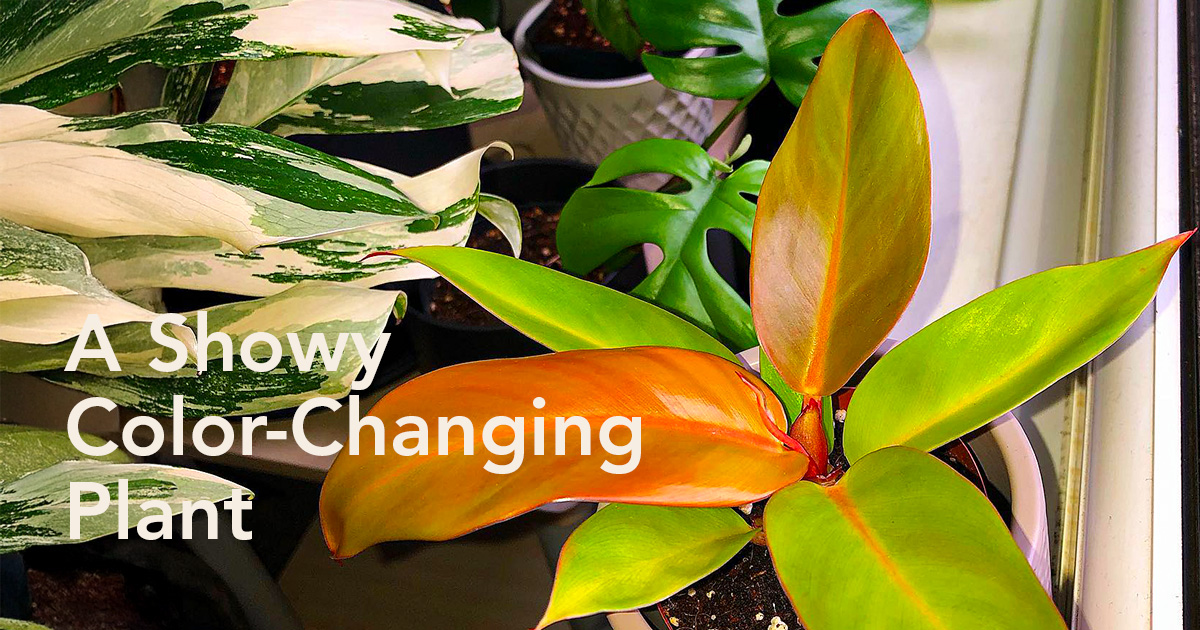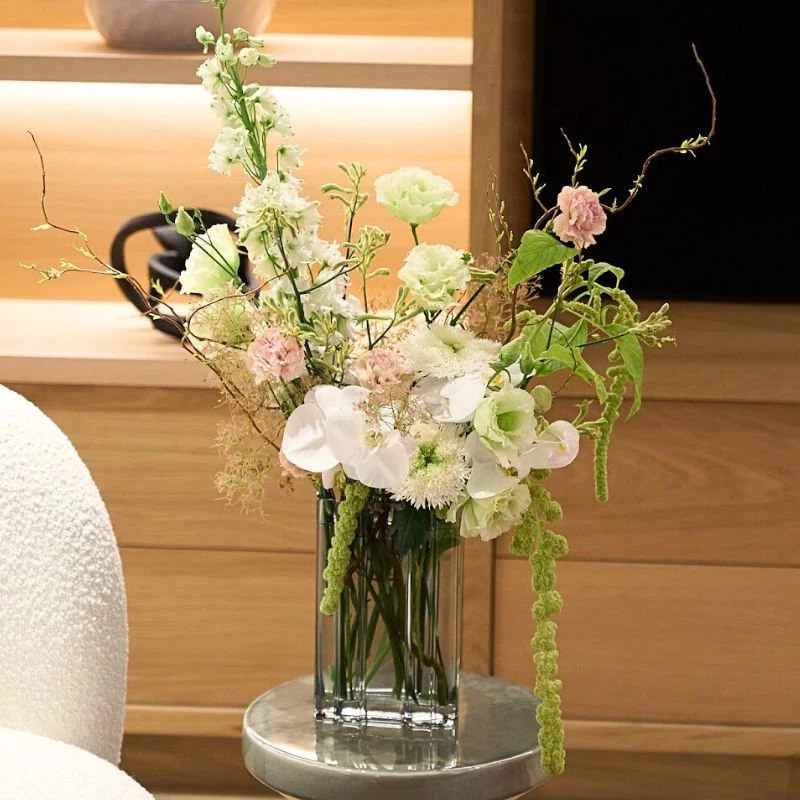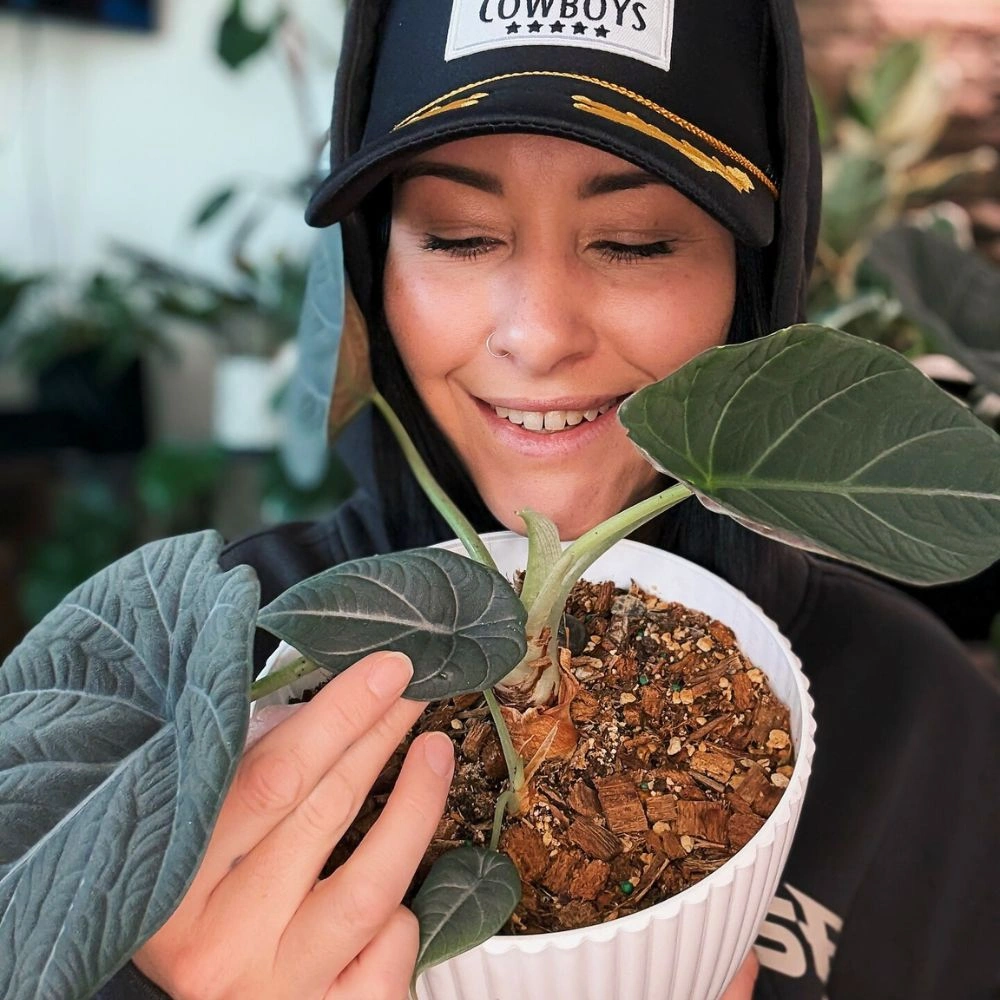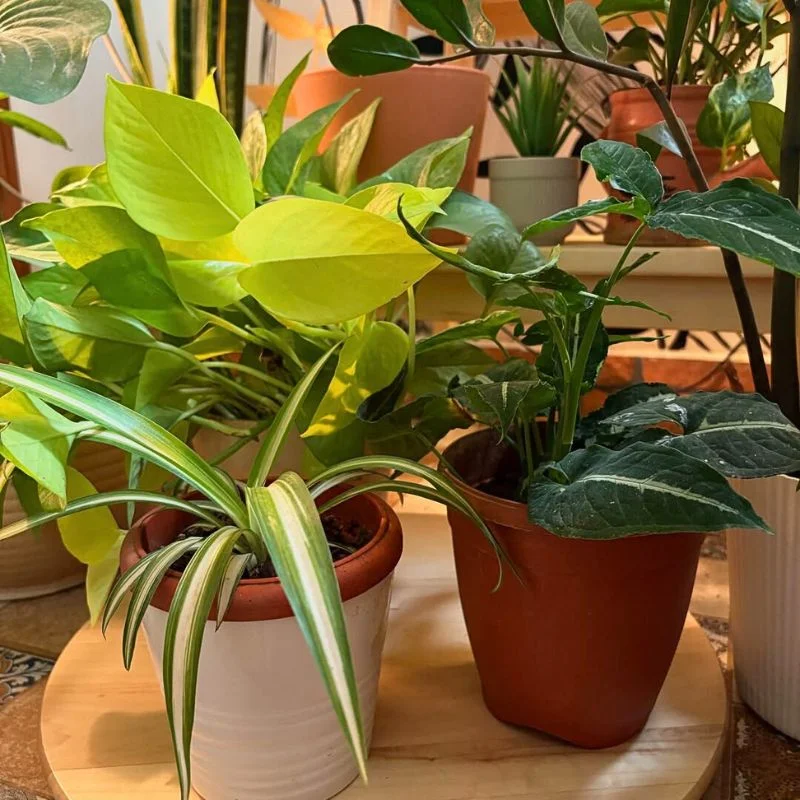A plant whose foliage showcases a stunning ombré of colors that beautifully transitions as it matures, the Philodendron Prince of Orange is one of the most visually enchanting houseplants available today, prized for both its vivid foliage and its compact growth habit. What makes this Philodendron variety truly amazing is its extraordinary color-changing leaves, which shift from brilliant orange to deep green. This quality makes this self-heading Philodendron increasingly sought after by collectors of all levels. Its compact growth habit, manageable size, and spectacular color display also make it an exceptional choice for indoor gardening.
Unlike many naturally occurring Philodendron species, this cultivar is the result of intentional hybridization, developed to highlight its unique coloration and upright structure. While its exact parentage remains a topic of speculation, it is widely believed to share lineage with other popular hybrids, such as the Philodendron McColley’s Finale. The Prince of Orange Philodendron’s hybrid development is credited to plant breeders aiming to combine the best traits of various Philodendron species, resulting in a plant that retains the resilience of its wild counterparts while showcasing dramatic aesthetic appeal.
Understanding the Philodendron Family
Philodendrons represent one of the largest genera of flowering plants, with hundreds of species ranging from vining climbers to upright plants. They fall within the family Araceae, known for their beautiful foliage and popularity as houseplants. As one of the Philodendron varieties, the Prince of Orange Philodendron emerged from extensive hybridization efforts starting in the 1960s, particularly in Florida.
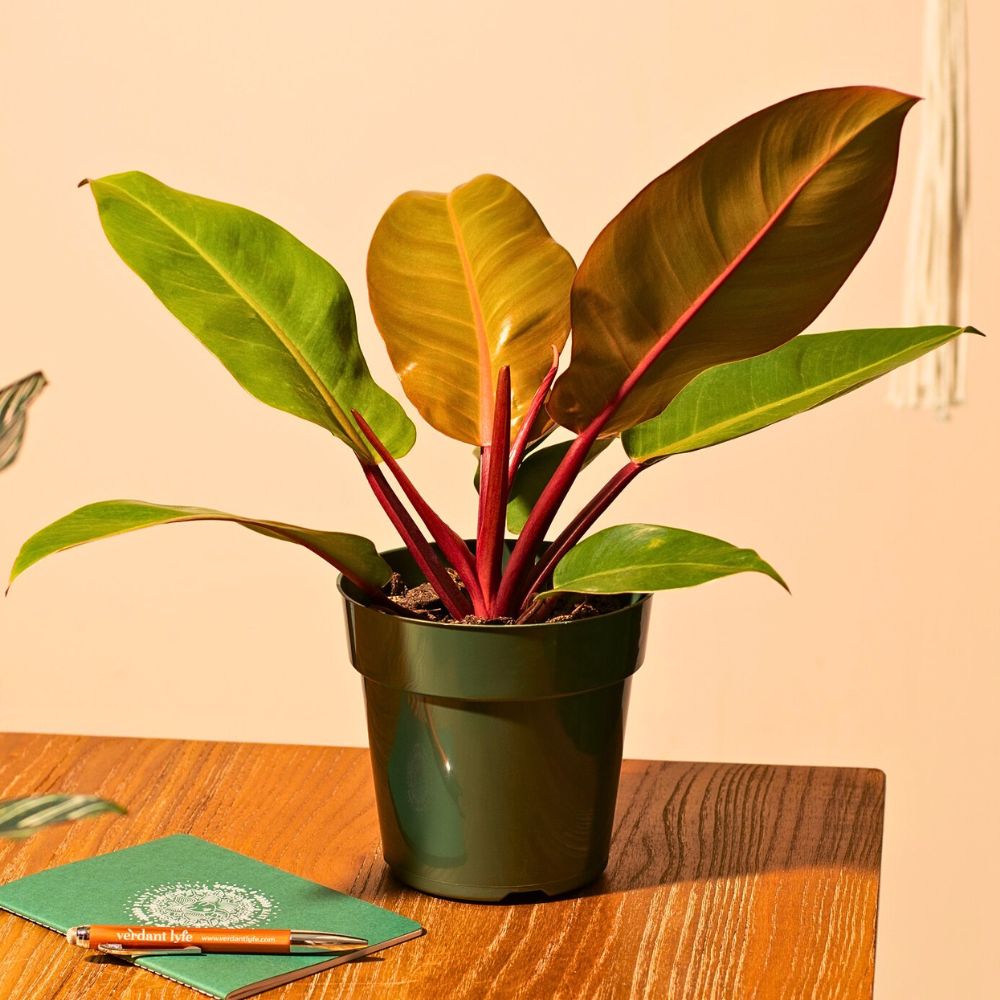
These breeding programs, including work by experts like Robert H. McColley, focused on developing self-heading Philodendron varieties with distinctive foliage colors. The resultant cultivars were a significant breakthrough in horticultural research and ornamental plant breeding.
Philodendron Prince of Orange Is a Hybrid Creation From Tropical Ancestors
Largely a cultivated variety, the Prince of Orange Philodendron does not quite exist in the wild. It is not a naturally occurring species but rather a carefully developed crossbreed created through selective breeding programs. But, it still belongs to the extensive Araceae family and is specifically classified as Philodendron erubescens 'Prince of Orange'.
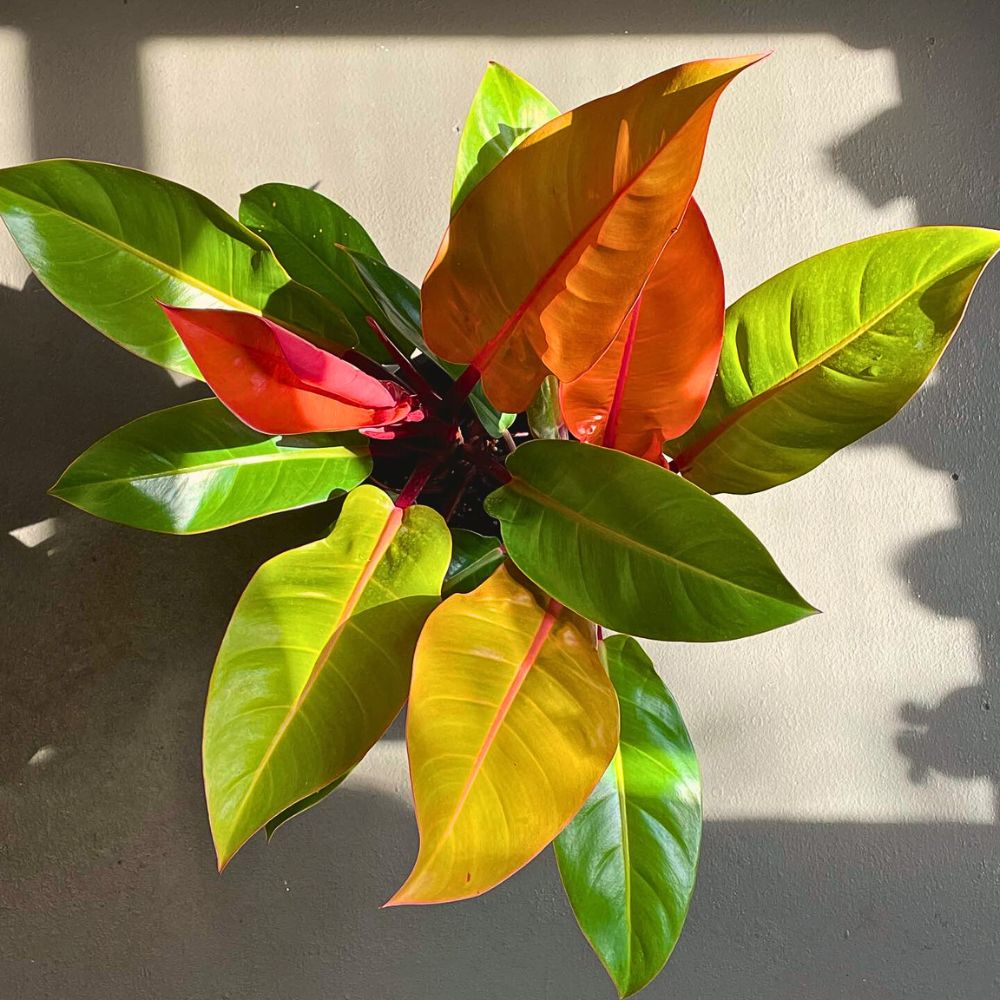
Distinct from many trailing varieties of Philodendron, this particular cultivar was developed to grow in an upright, self-heading pattern that creates a characteristic rosette formation, even though like the others, the plant's lineage traces back to the lush rainforests of South America, where Philodendrons naturally thrive in the humid, filtered light conditions of the tropical jungle floor.
Distinctive Features of the Prince of Orange Philodendron
What makes the Prince of Orange Philodendron really spectacular is its remarkable color-changing capability. New leaves emerge with a vibrant orange hue reminiscent of a tropical sunset, creating a stunning visual display. As these leaves mature, they undergo a fascinating transformation, gradually shifting through shades of copper and bronze. Over time, they transition to glossy deep green, giving the plant a dynamic, multi-tonal appearance.
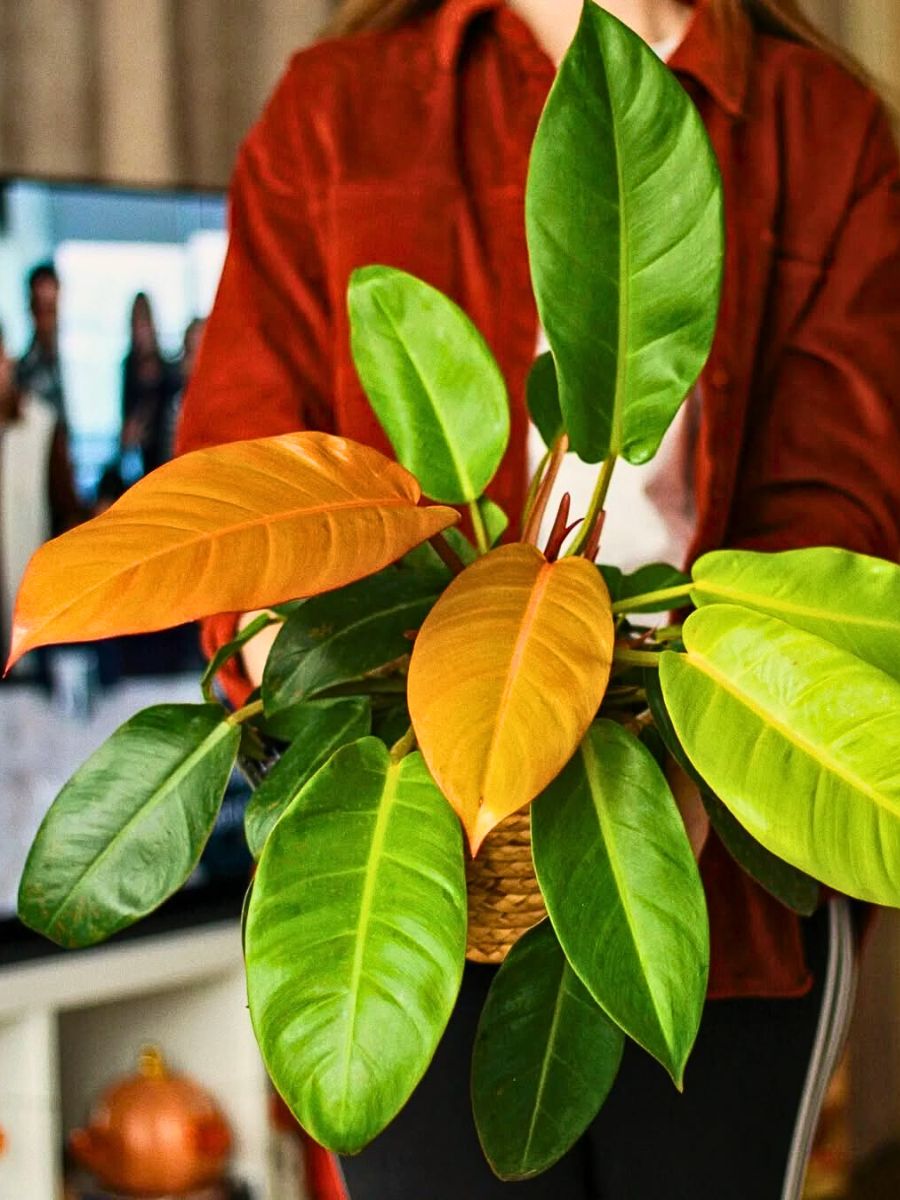
This continuous color metamorphosis means the plant simultaneously displays multiple color stages, creating a gradient effect that few other houseplants can match. The Philodendron Prince of Orange mature specimens showcase this multi-colored display most impressively, with the color contrast becoming more pronounced as the plant develops a fuller form.
The Prince of Orange Philodendron also grows in a distinctive rosette pattern, with new leaves emerging from the center and older leaves spreading outward to create a symmetrical, layered appearance. Its leaves are broad and elongated, typically reaching 15-20 cm (6-8 inches) in length, with a smooth, glossy texture that enhances their visual appeal. The leaves feature prominent midribs and display the characteristic heart-shaped base common to many Philodendron varieties, though more elongated and less deeply lobed than some of its Philodendron kin.
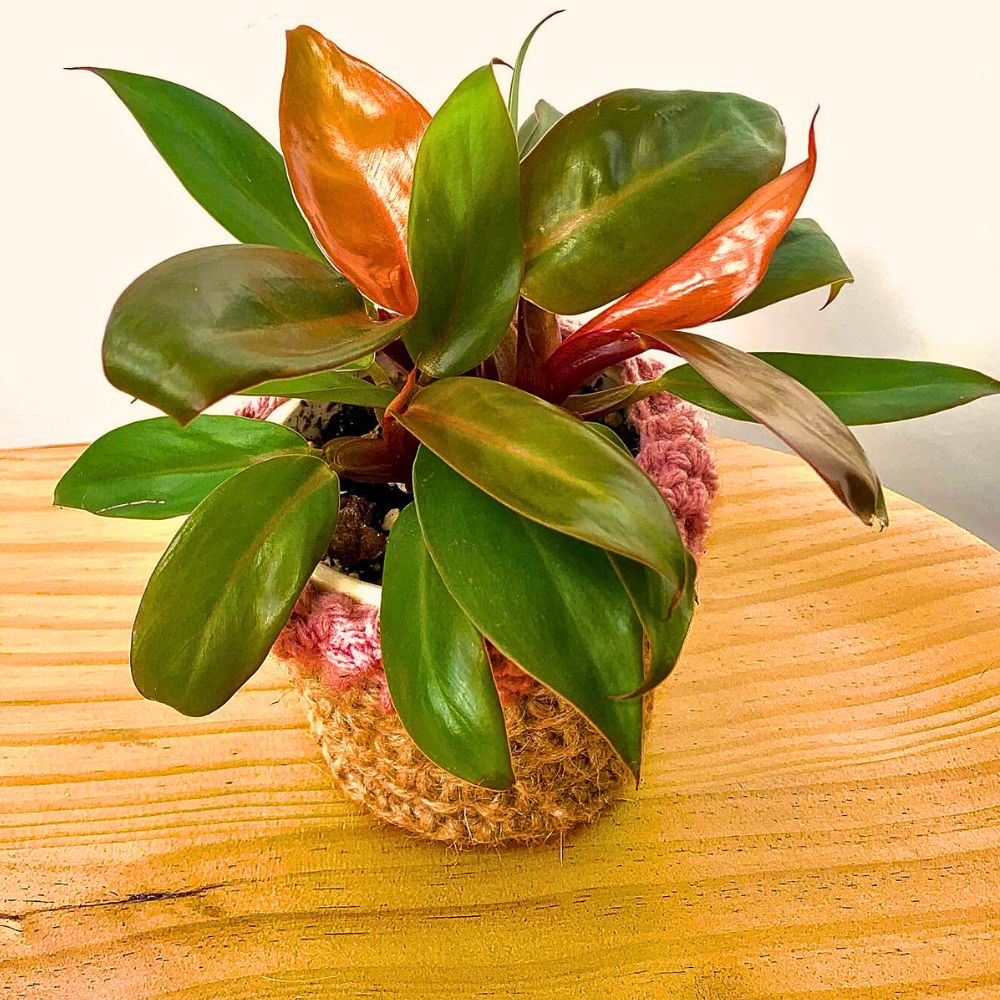
Quite unlike vining Philodendrons that require support structures, the Prince of Orange maintains an upright, self-supporting growth habit. This self-heading characteristic makes it particularly well-suited for tabletop displays and areas where space might be limited. Plus, the compact nature of this plant ensures it remains a manageable size even as it matures, thus making it suitable for a variety of interior settings without becoming unwieldy.
Comparing the Varieties
Philodendron Prince of Orange is often confused with similar cultivars like the Philodendron McColley’s Finale and the Philodendron Orange Princess. However, subtle differences set them apart.
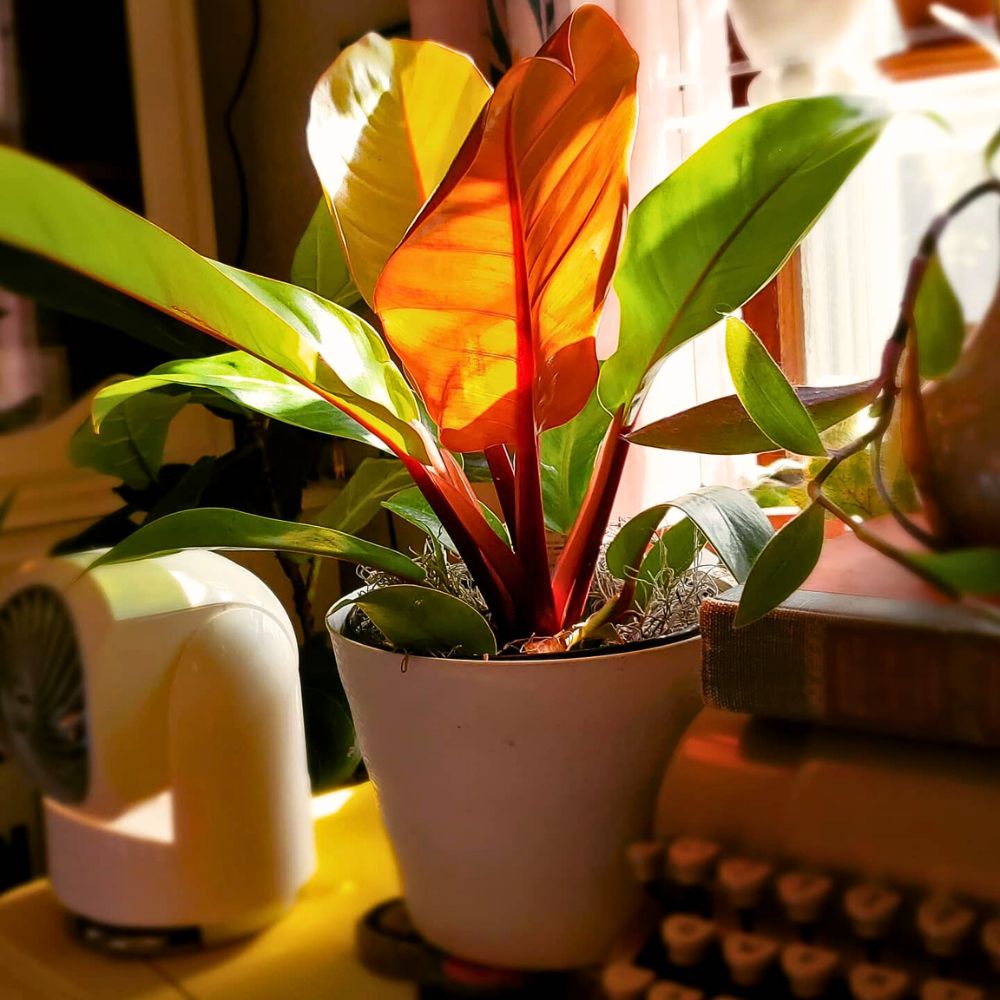
Philodendron Prince of Orange vs. Orange Princess Philodendron vs. Philodendron McColley’s Finale
The two varieties with similar-sounding names—Philodendron Orange Princess and Philodendron Prince of Orange—are often confused with each other. The Prince of Orange Philodendron is renowned for its dramatic leaf color transformation, with new leaves emerging with a vibrant orange hue that gradually transitions to green as they mature. This color-changing characteristic is one of its most appealing features. The intensity of the orange coloration in new growth is directly related to light exposure—brighter light conditions produce more vivid orange tones in emerging leaves.

Philo Orange Princess, on the other hand, is distinguished by its multicolored foliage displaying a combination of three colors: green, yellow, and orange. The leaves are typically long and slender, with orange-green coloration featuring white-yellow variegation throughout. This variegation pattern is a defining characteristic that separates it from other Philodendron varieties. Another distinctive feature is its burgundy stalks, which contrast with the colorful foliage and enhance the plant's overall visual appeal. Also, Philo Orange Princess (sometimes incorrectly labeled) typically shows more salmon-pink to peach tones in new growth. The comparison between the Philodendron Orange Princes and Prince of Orange also reveals differences in growth patterns and mature size, with the Prince of Orange Philodendron generally developing a more compact form.
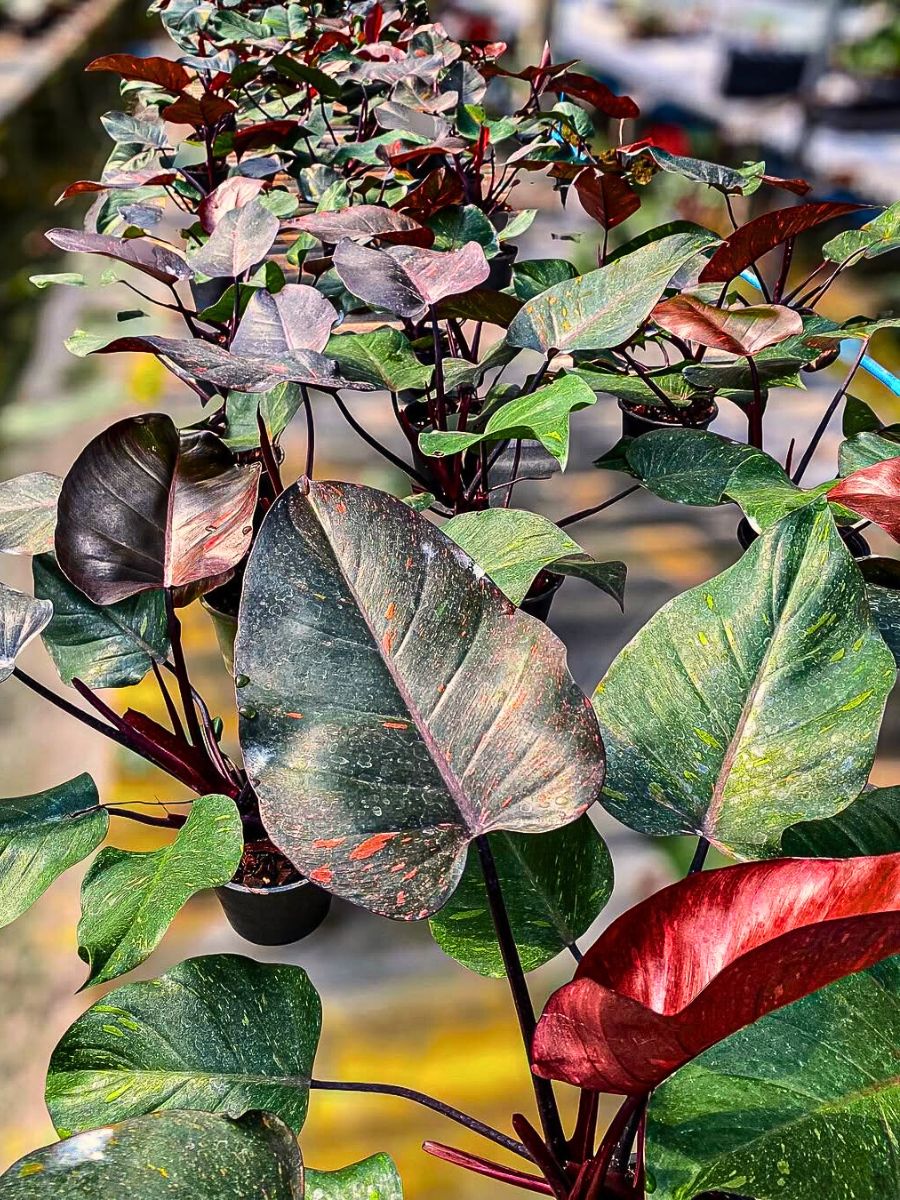
Conversely, the Philodendron McColley's Finale characterizes another closely related hybrid that shares certain characteristics with the Prince of Orange. Developed within the same breeding programs, McColley's Finale Philodendron distinguishes itself with new leaves emerging rounder and with slightly different coloration patterns. It comes in rich chestnut red rather than orange, creating a different but equally striking visual effect. Also, McColley’s Final Philodendron often displays a more structured, layered growth pattern. Both plants, however, share the self-heading growth habit and similar care requirements, making them complementary additions to tropical plant collections.
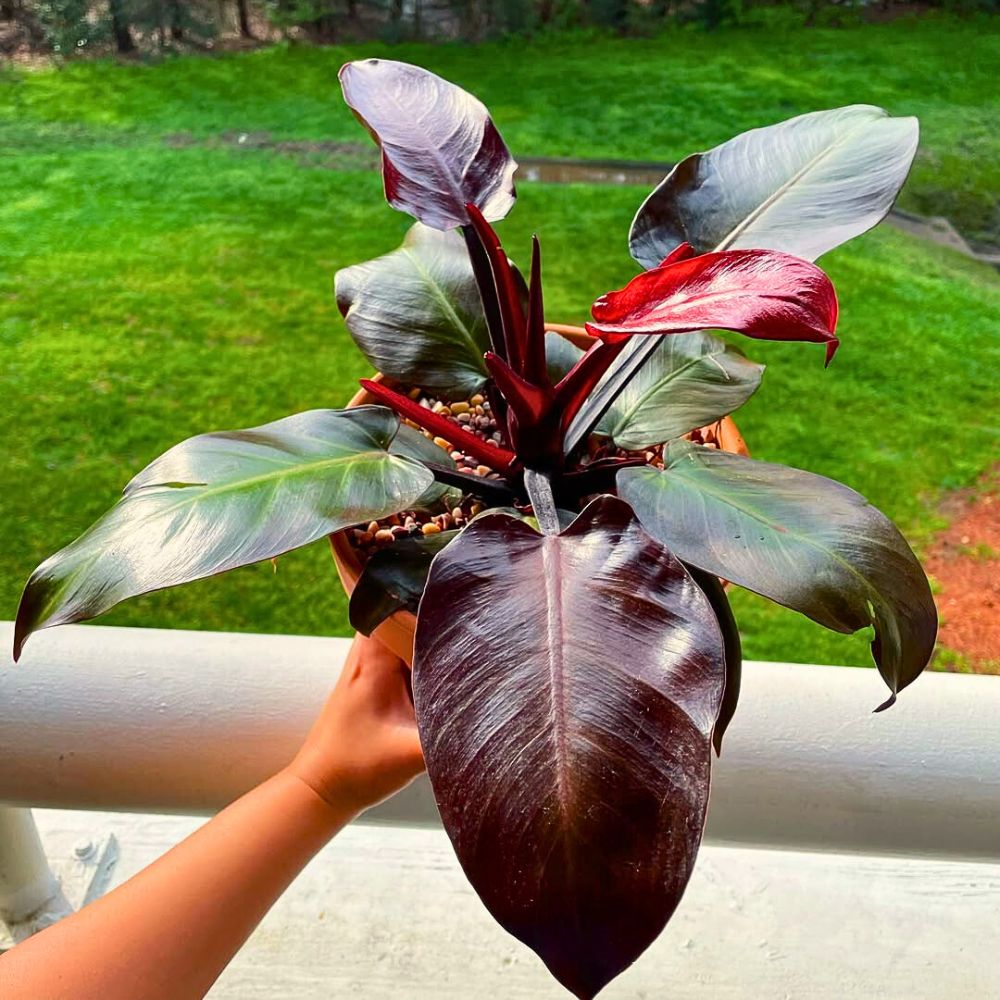
That, notwithstanding, each variety offers unique ornamental qualities while maintaining the relatively easy care profile that makes Philodendrons popular houseplants. Moreover, understanding these distinctions helps plant parents to make informed choices, especially when seeking out the Prince of Orange Philodendron for sale or its related varieties through nurseries or online retailers.
How Big Does a Philodendron Prince of Orange Get?
Often, a common question among potential plant owners concerns the ultimate size of the Philodendron Prince of Orange. When provided with optimal growing conditions, a mature Philodendron Prince of Orange typically reaches heights of 60-90 cms (24-36 inches). Rather than growing tall and lanky, these plants tend to develop a broader spread than height, often forming rosettes with diameters approximately twice their height.
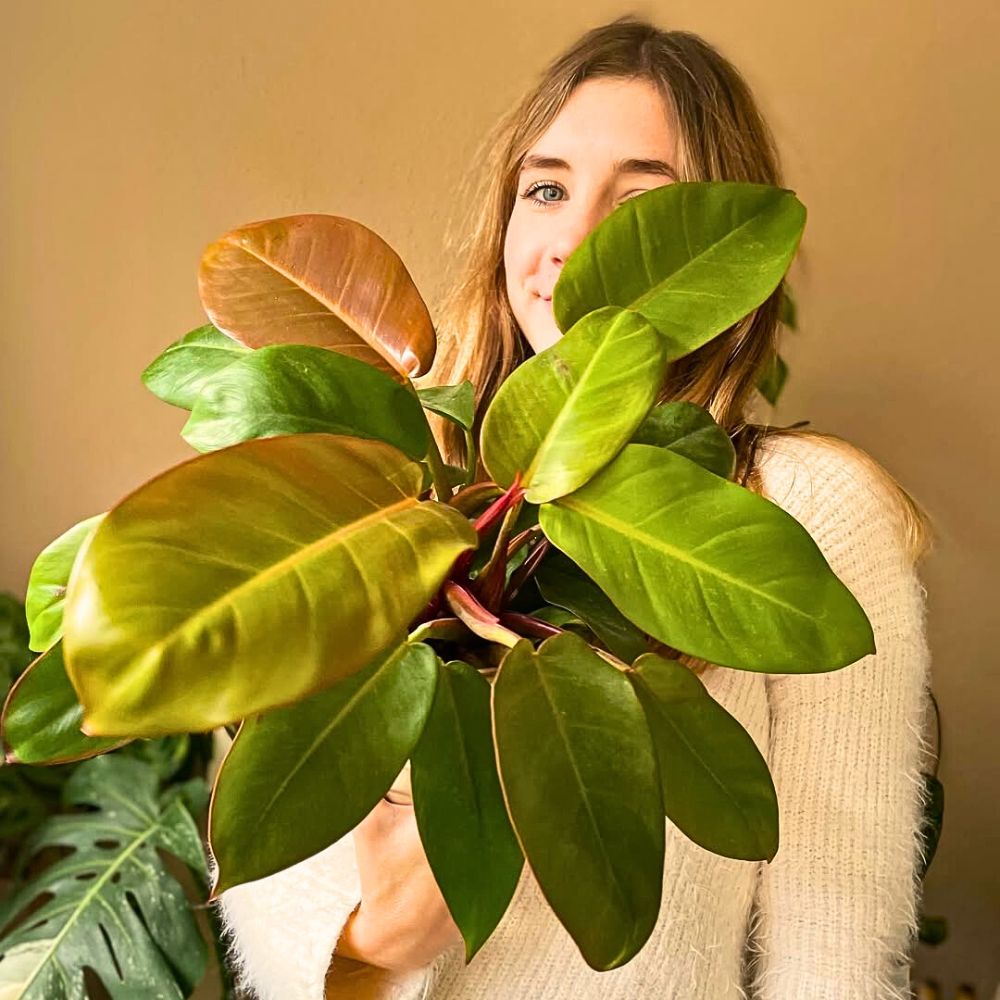
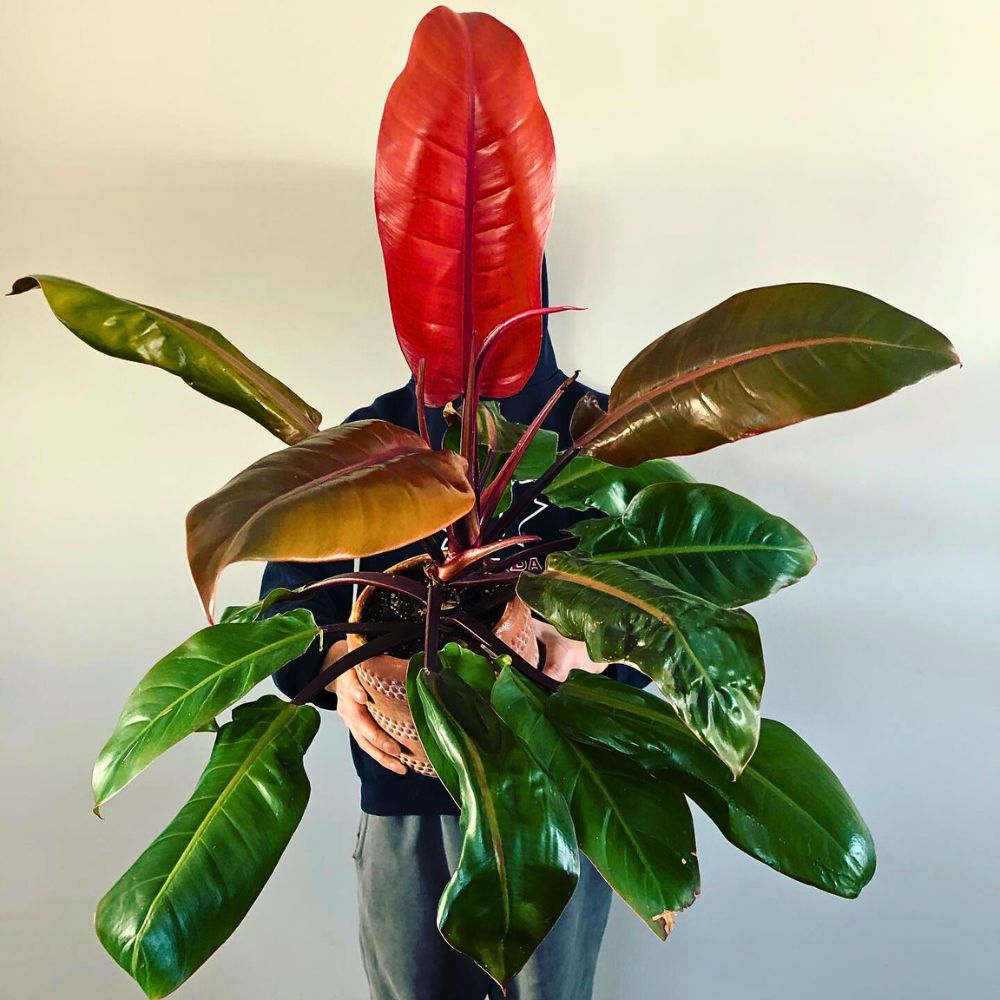
How big does Philodendron Prince of Orange get in width? Most specimens will achieve a spread of approximately 60-90 cms (24-36 inches) at full maturity, creating a substantial but not overwhelming presence. This moderate size makes the plant versatile for various placements throughout the home, from tabletops to floor displays, without requiring excessive space.
Comprehensive Care Guide for Philodendron Prince of Orange
As a cultivated hybrid, this houseplant’s growth and care requirements are shaped by its tropical origins and the intentional breeding that emphasizes its striking aesthetics. So, whether one is a rookie plant parent or a veteran collector, mastering how to care for Prince of Orange Philodendrons ensures this plant remains a vibrant, long-lasting centerpiece in your home.
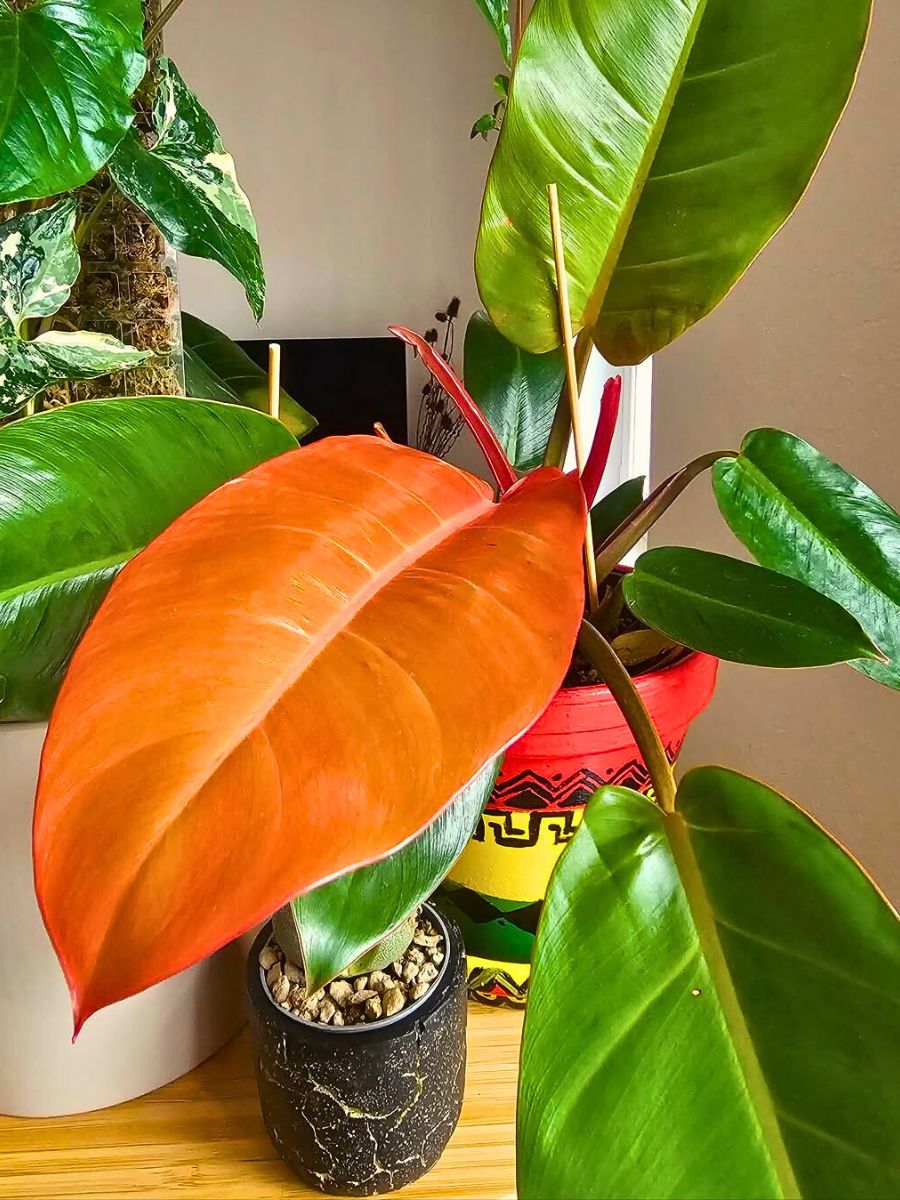
Light Requirements and Placement
Understanding how to care for Philodendron Prince of Orange begins with providing appropriate lighting. This tropical beauty thrives in bright, indirect light, which mimics its natural understory habitat in rainforests. Direct sunlight can scorch the vivid foliage, while insufficient light may cause the plant to produce less vibrant coloration and exhibit leggy growth. An east or north-facing window often provides ideal lighting conditions, though the plant can adapt to medium-light situations.
One notable characteristic that makes the Prince of Orange Philodendron particularly appealing is its versatility regarding light conditions. It can tolerate lower light levels better than many other colorful tropical plants, though the vibrant orange coloration may be less pronounced in insufficient light.

Watering and Humidity Needs
Proper watering forms a crucial aspect of Prince of Orange Philodendron care. These plants prefer consistent moisture without becoming waterlogged. The ideal approach involves allowing the top 3-5 cm (1-2 inches_ of soil to dry out between thorough waterings. Overwatering presents the greatest risk, potentially leading to root rot and other moisture-related issues. During active growth periods in spring and summer, more frequent watering may be necessary, while winter months typically require reduced irrigation.
While originating from humid tropical environments, the Prince of Orange Philodendron demonstrates impressive adaptability to average household humidity levels. That said, increased humidity supports optimal growth and more vibrant foliage. Methods for increasing humidity include grouping plants, using pebble trays with water, or employing a humidifier in particularly dry environments or during winter months when indoor heating systems reduce ambient moisture.
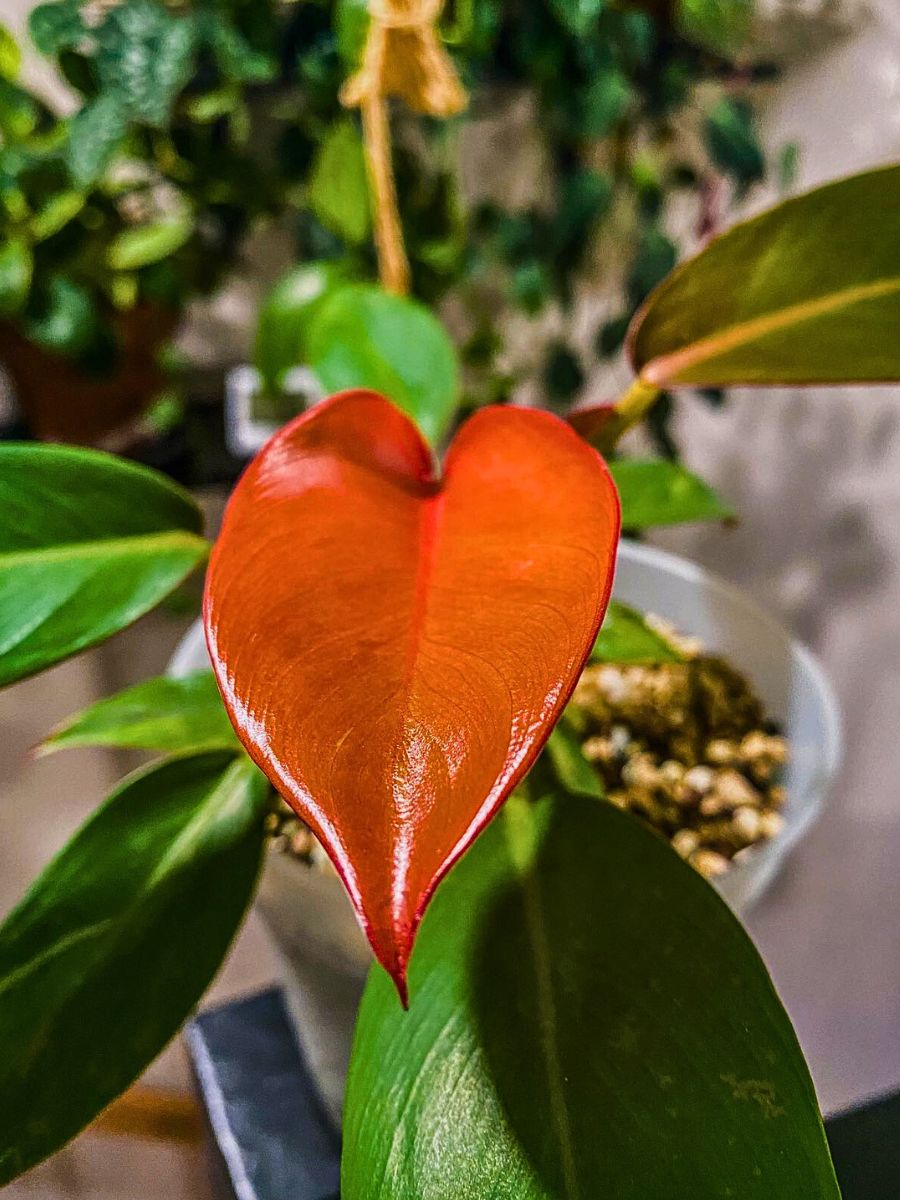
Soil and Fertilization
The Prince of Orange Philodendron performs best in well-draining potting media that retains some moisture while allowing excess water to pass through freely. An ideal soil mix combines peat-based potting soil with perlite, orchid bark, and perhaps some charcoal for improved drainage and aeration. This blend provides both the moisture retention and aeration that Philodendrons require for healthy root development.
For fertilization, a balanced liquid houseplant fertilizer applied every four weeks during the growing season (spring through autumn) supports robust growth and vibrant coloration. During winter months, when growth naturally slows, reducing fertilization to once every eight weeks prevents nutrient build-up while still supporting the plant's minimal nutritional needs. Over-fertilization can damage roots and cause leaf burn, so following recommended dilution rates remains essential for maintaining plant health. But then again, a Philodendron Prince of Orange mature plant may benefit from occasional foliar sprays containing micronutrients to enhance leaf vibrancy.
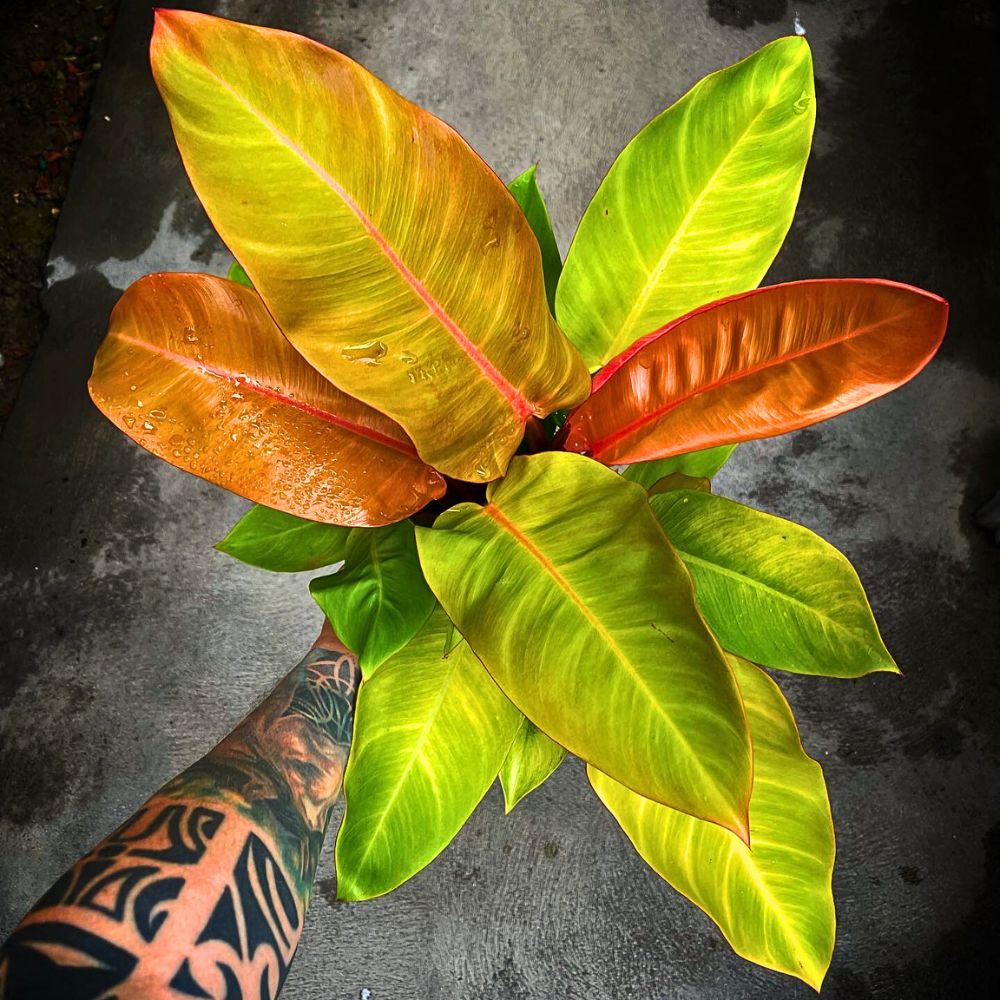
Temperature Considerations
When learning how to care for Prince of Orange Philodendrons, understanding temperature requirements proves essential. These tropical plants maintain their form and color best within a temperature range of 15°C to 32°C. They can tolerate brief periods slightly outside this range but should be protected from extreme temperature fluctuations, cold drafts, and exposure to heating or cooling vents that could stress the plant. Indoor locations that maintain relatively stable temperatures year-round provide ideal growing conditions for these Philodendrons.
Potting and Repotting
The Prince of Orange Philodendron grows relatively quickly compared to many houseplants and generally requires repotting every 1-2 years. Signs indicating its repotting needs include roots emerging from drainage holes, water running straight through the pot rather than being absorbed, or a noticeable slowing of growth despite appropriate care. When repotting, select a container only 3-5 cm (1-2 inches) larger in diameter than the current pot to prevent excess soil that could retain too much moisture. Fresh, well-draining potting medium rejuvenates the plant and provides space for continued growth.
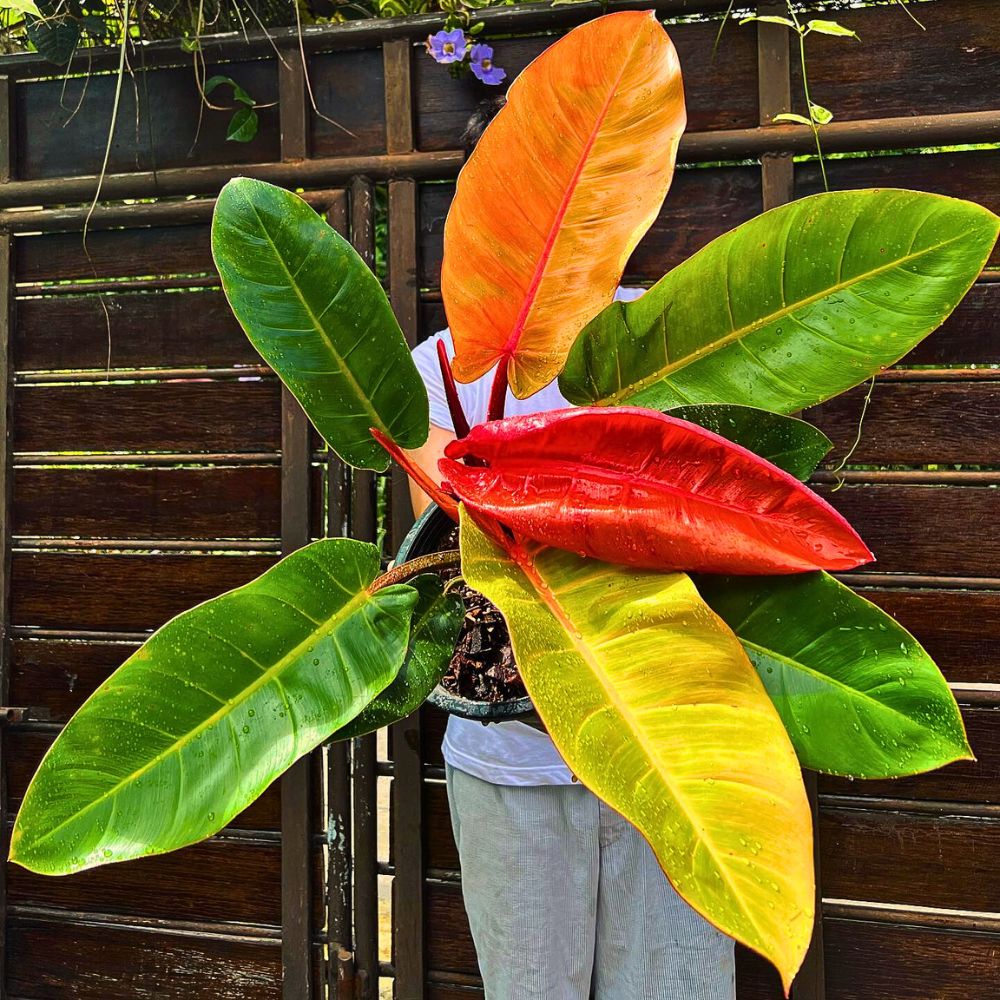
Pruning and Maintenance
Pruning of this houseplant is minimal but beneficial. Remove yellowing or damaged leaves at the base using sterilized scissors to redirect energy to healthy growth. Also, wipe its leaves with a damp cloth monthly to remove dust, ensuring optimal photosynthesis. Regular pruning also helps manage the plant’s size. While how big a Philodendron Prince of Orange gets is generally predictable, occasional trimming can maintain a compact, luxuriant appearance.
How to Propagate Your Prince of Orange Philodendron
Propagating the Prince of Orange Philodendron allows gardeners to expand their collection or share this remarkable plant with others. The most reliable propagation method involves stem cuttings taken from healthy parent plants. To successfully propagate through stem cuttings, select a healthy stem with at least two nodes, make a clean cut just below a node, and remove lower leaves, leaving 1-2 leaves at the top. The cutting can then be rooted in either water or directly in a suitable potting medium.
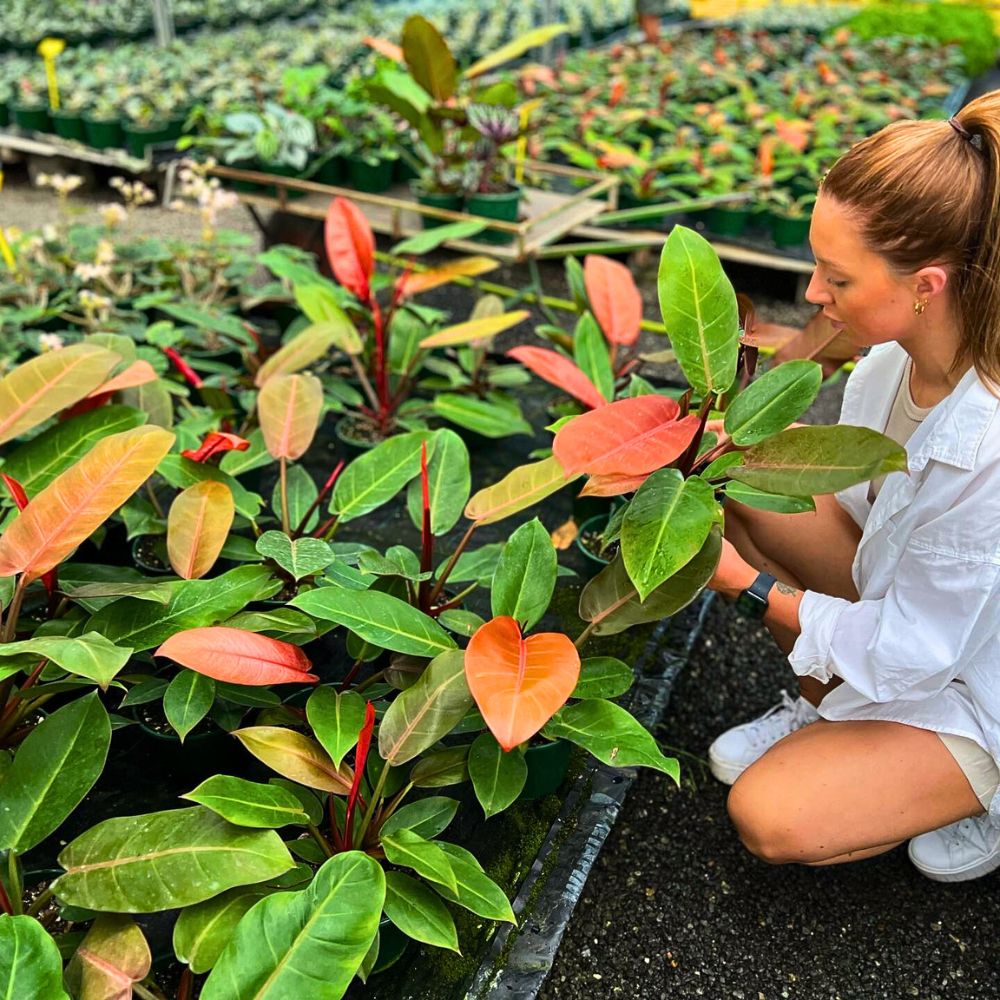
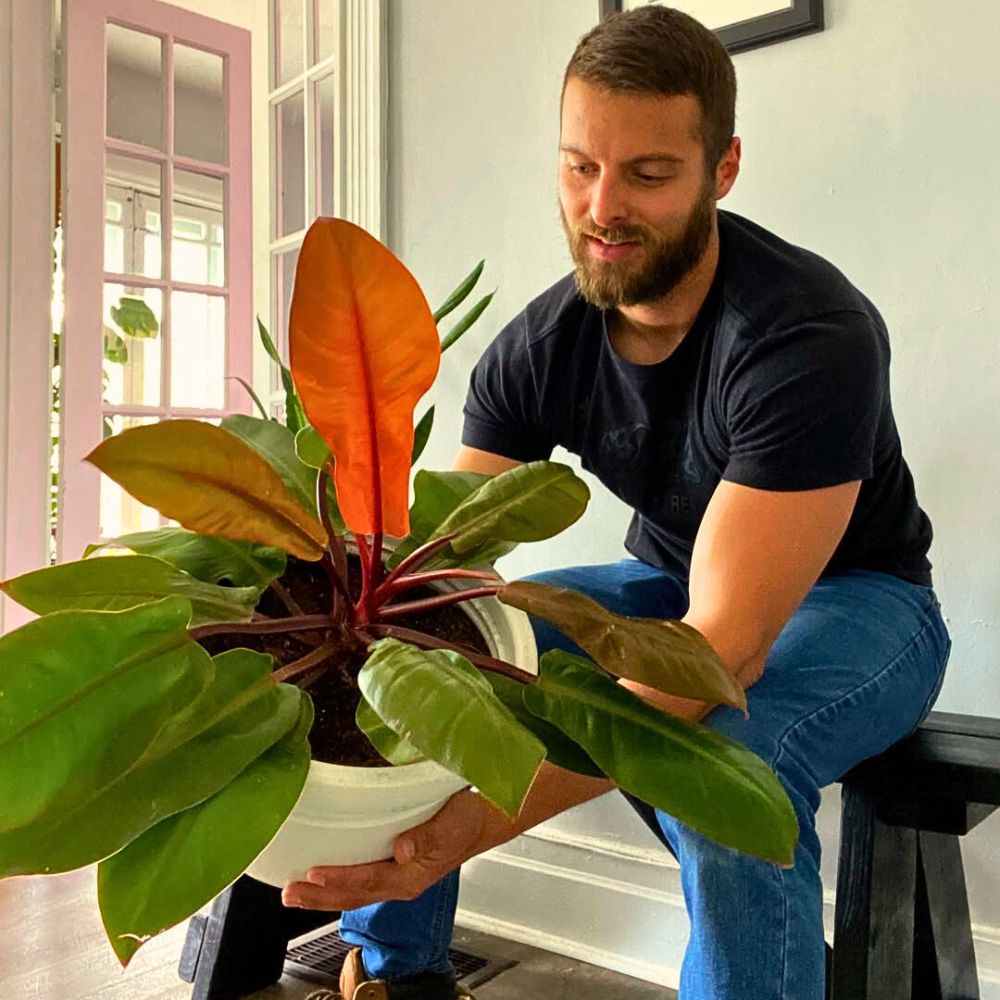
For water propagation, place the cutting in a jar with the nodes submerged, changing the water every few days to prevent bacterial growth. Roots typically develop within 2-4 weeks, after which the cutting can be transferred to the soil once roots reach 3-5 cm (1-2 inches) in length. For soil propagation, plant the cutting directly in a moist, well-draining medium, cover it with a clear plastic bag to maintain humidity, and place it in bright indirect light until new growth indicates successful rooting.
Another effective propagation technique specifically for the Prince of Orange Philodendron involves the division of crown offshoots. As these self-heading Philodendrons mature, they often produce small offshoot plants around their base. These can be carefully separated during repotting by ensuring each division has both roots and leaves attached. Plant each division in an appropriate potting medium, water thoroughly, and place in moderate indirect light while they establish. This method produces new plants that are already somewhat established, often resulting in faster development than stem cuttings.
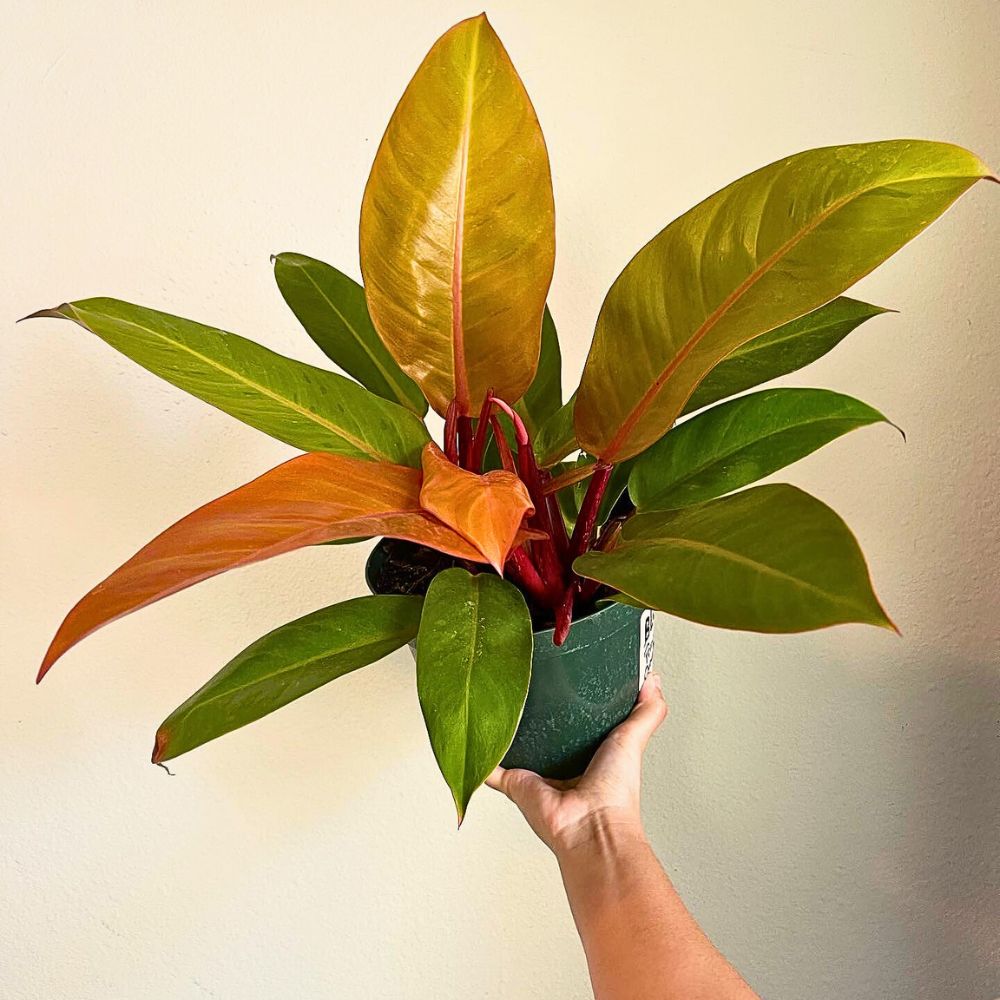
Ensuring Successful Growth After Propagation
Regardless of the propagation method, a newly propagated Prince of Orange Philodendron requires consistent environmental conditions to establish successfully. Maintain even moisture without waterlogging, provide bright indirect light, and ensure warm temperatures between 21-27°C to encourage root development. Avoid fertilizing newly propagated plants until signs of new growth appear. These indicate that the root system has been sufficiently established to use nutrients properly.
Incorporating Your Philodendron Prince of Orange in Indoor Spaces
The lively, ever-changing coloration of the Prince of Orange Philodendron makes it an exceptional focal point in different interior settings. Its compact growth habit allows for versatile placement options throughout the home. In living rooms, these plants provide a tropical accent when positioned on coffee tables or side tables where their colorful foliage can be appreciated at eye level. In a home office, they bring a touch of nature that enlivens the workspace without requiring extensive maintenance. Bedrooms likewise can benefit from their air-purifying qualities while providing a serene natural element that enhances relaxation.

Creating Stunning Plant Displays
The Prince of Orange Philodendron works exceptionally well in mixed plant groupings, where its vibrant orange new growth creates a delightful contrast against plants with different foliage colors and textures. Pairing it with plant life featuring purple, blue-green, or deep green foliage maximizes visual impact through complementary color relationships. The plant's symmetrical growth pattern also makes it suitable for standalone display in decorative containers that complement interior design schemes, from modern minimalist to bohemian or tropical aesthetics.
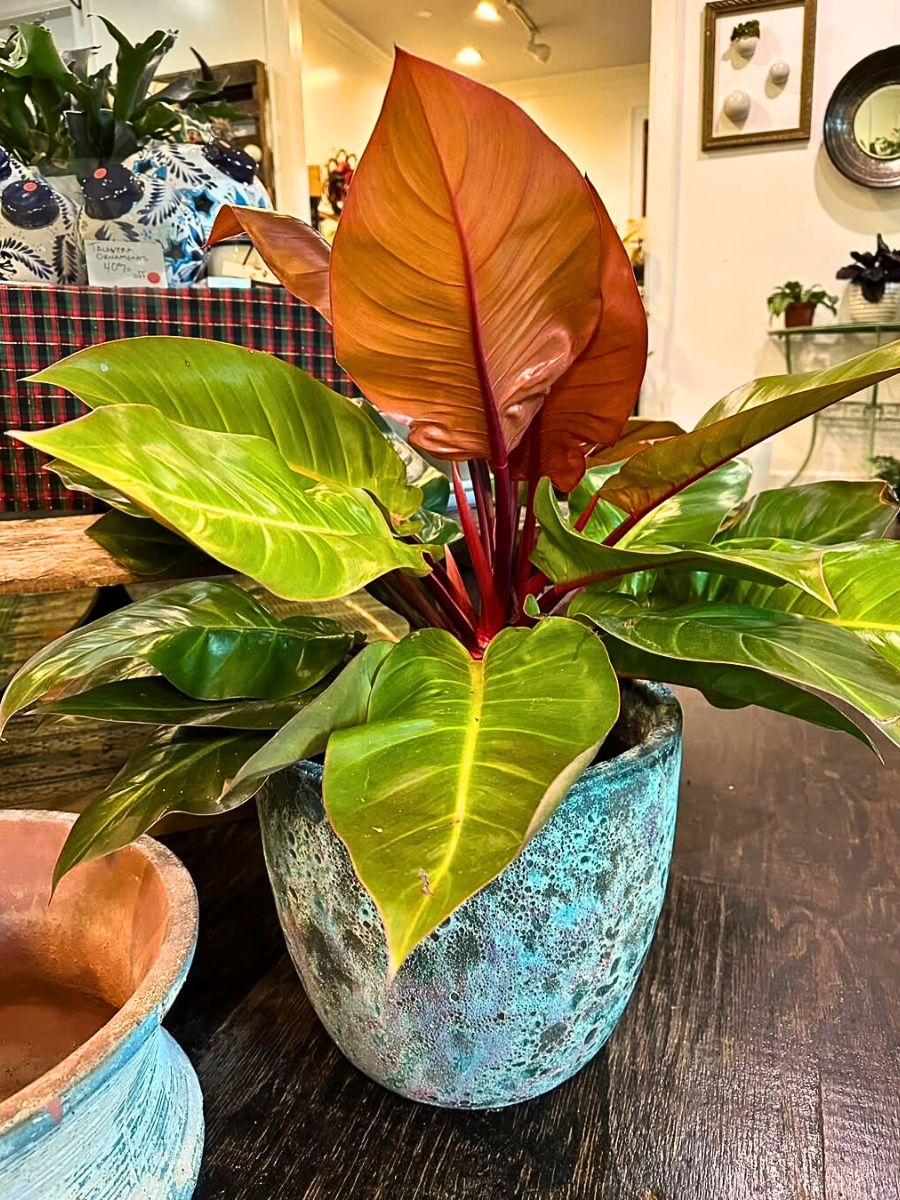
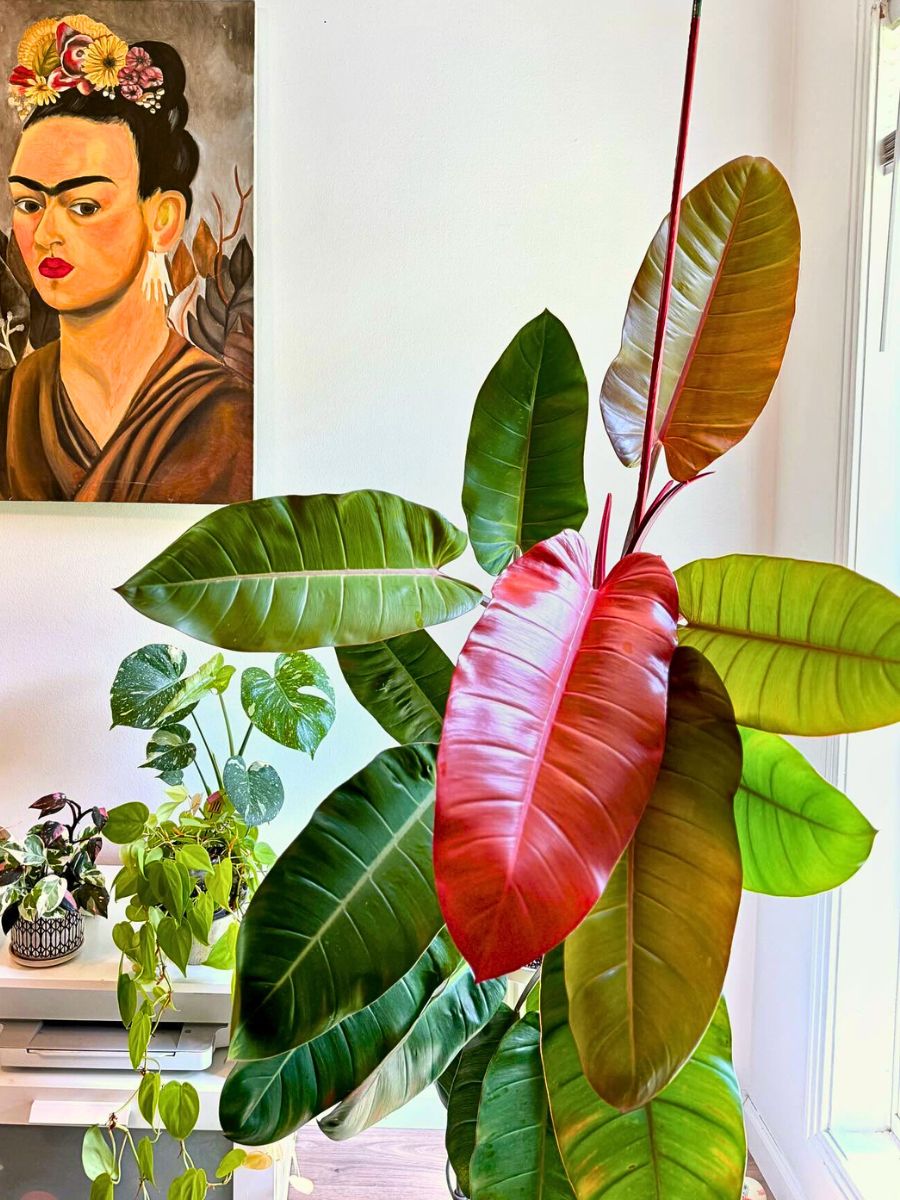
The Prince of Orange Philodendron's Air-Purifying Benefits
Away from its ornamental value, the Prince of Orange Philodendron offers practical benefits through its air-purifying capabilities. Like many members of the Araceae family, it effectively removes certain airborne toxins while collecting dust particles that could otherwise affect indoor air quality. These air-cleaning properties make it particularly valuable for urban dwellings or spaces with limited ventilation. It therefore contributes to healthier indoor environments while simultaneously enhancing aesthetic appeal, exemplifying the perfect combination of form and function in interior plantscaping.
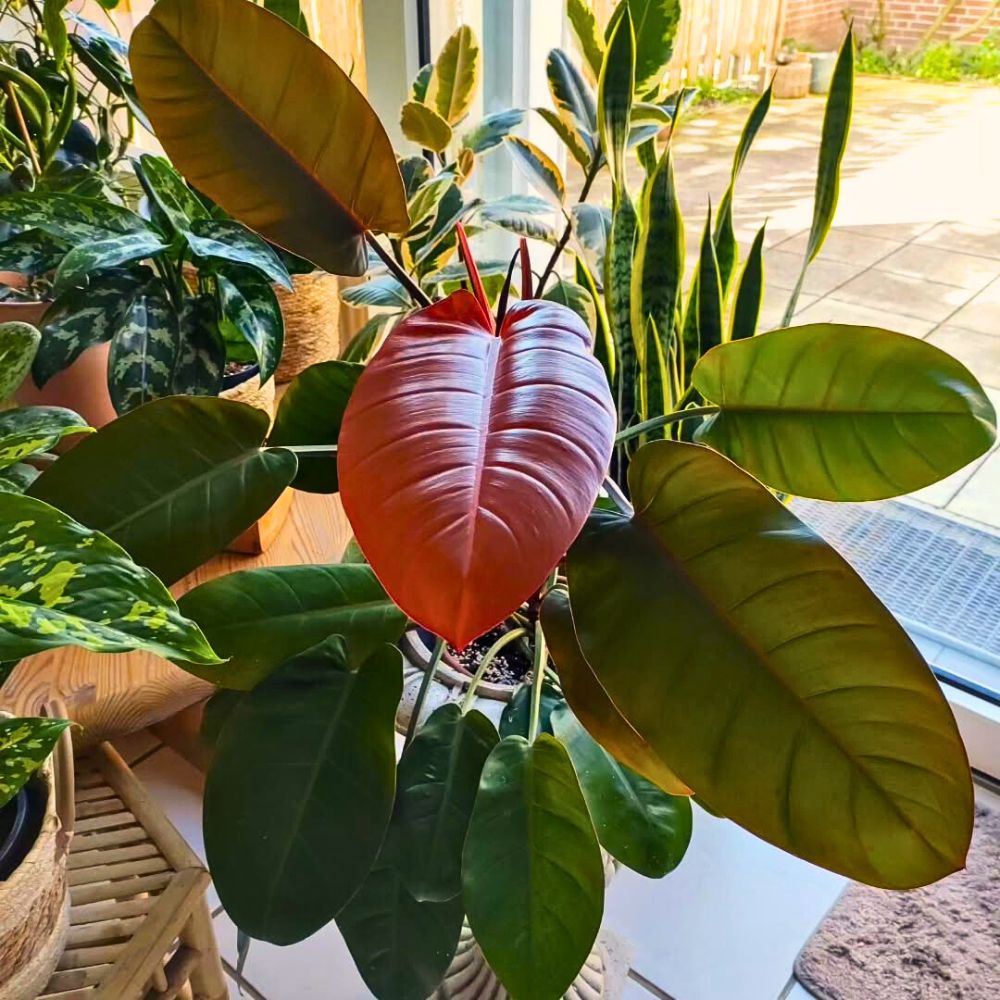
With the growing interest in unique and distinctive houseplants, the Prince of Orange Philodendron offers remarkable diversity and showcases the indoor beauty that carefully bred hybrid plants can bring to your interiors.
Feature image by @plantyapartment, header image by @plants_manchester.

